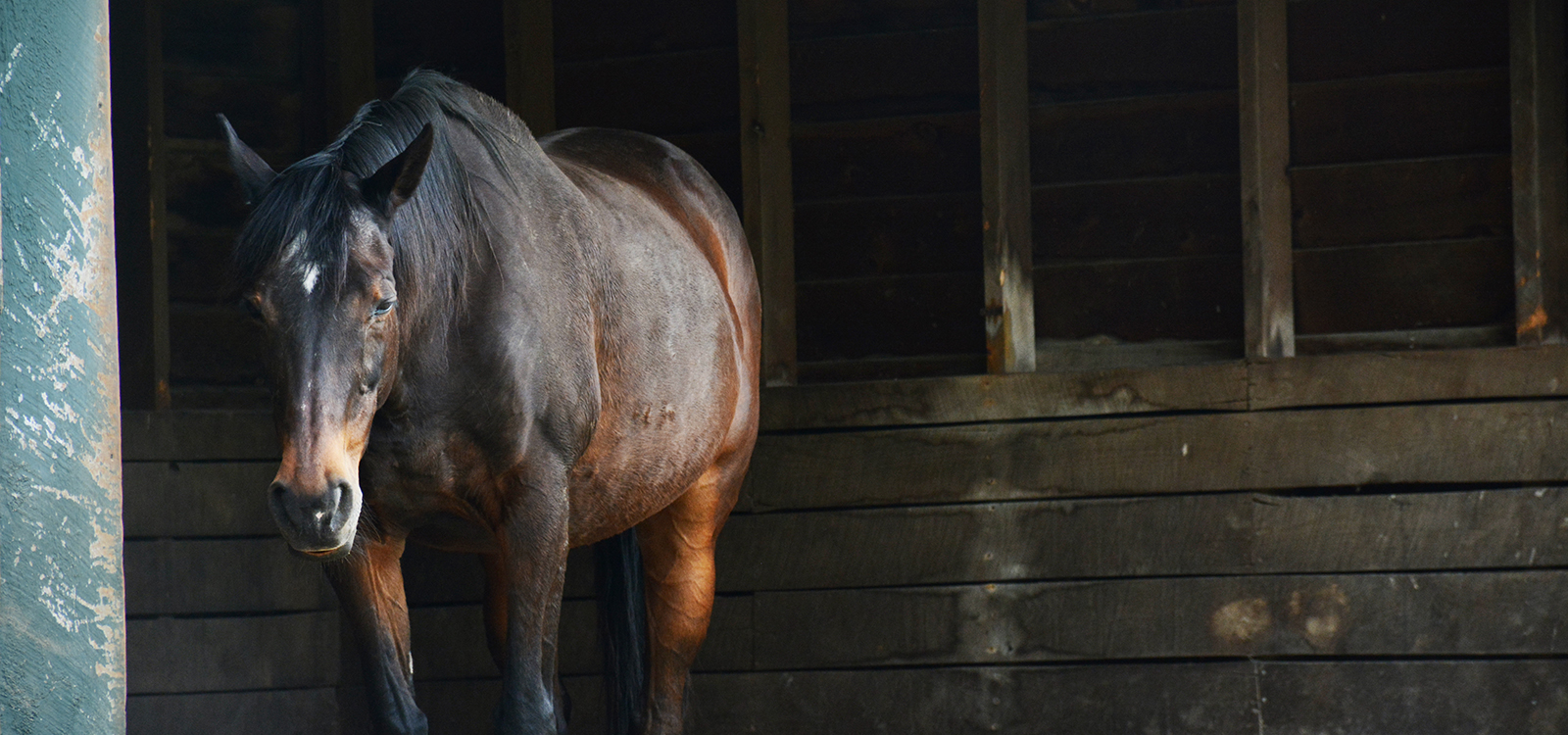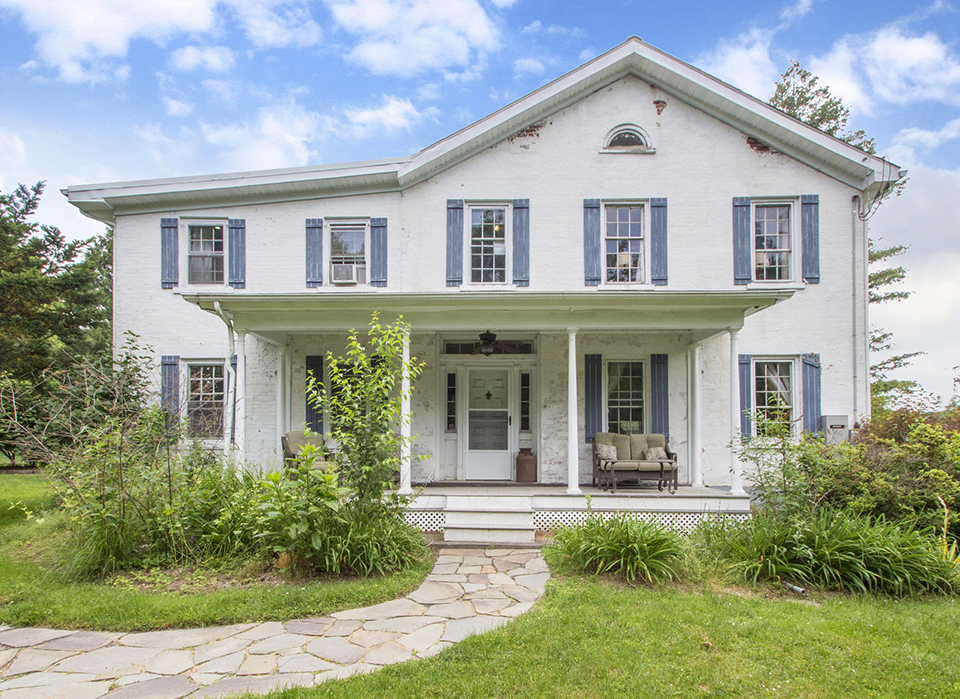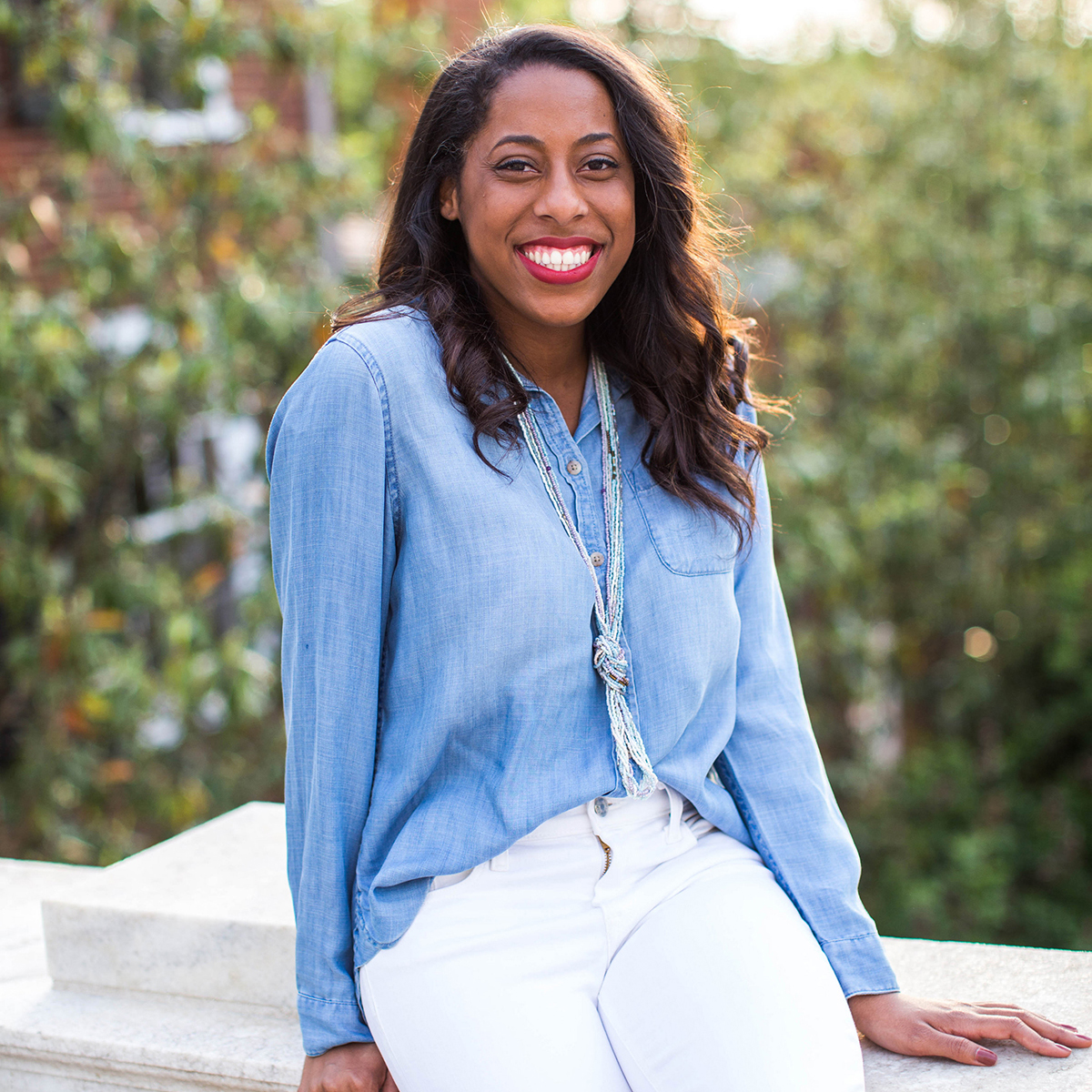What My Experience at the Catskill Animal Sanctuary Taught Me About Cruelty
I turned away from the crates and tried to focus on something else. When I did, I noticed these words nailed to the side of a green wooden barn: “Life is life — whether in a cat, or dog, or man.” Or in this case, pig. “There is no difference there between a cat or a man. The idea of difference is a human conception for man’s own advantage.”
That last line struck a chord. As an African-American woman in America, I’m no stranger to the prejudice of difference. As I stared into those cramped metal crates, the ones holding living beings for four months at a time, an image of a slave ship flashed into my mind. When I began to learn about the African slave trade, one depiction stood out, and I continue to carry it. It captured the interior of a slave ship and hundreds of Africans bound for America, who lay sandwiched and stuffed in the ship’s hull. Slavery was a 400-year system rooted in the human conception of difference and the advantage that difference creates. When people talk about slavery, they’ll often say, “We were treated like animals.” But animals don’t deserve to be treated that way either.
The Catskill Animal Sanctuary was created in 2001 to combat the agricultural industry’s conception of difference. Founded by Kathy Stevens, the Catskill Animal Sanctuary has two main locations in New York state and has rescued over 4,000 animals since its opening. When the organization began, it offered a modest tour. But today the sanctuary offers a vegan culinary program, a children’s camp, a leadership camp for older kids, and a New York City-based panel series called Catskill Conversations. Stevens also says the sanctuary will launch a mentorship program this fall pairing vegans with those transitioning to veganism as accountability partners. They also offer an ethical choices program, which sends a humane educator to speak to groups across the nation. The sanctuary attracts about 5,000 visitors a year, only half of which are vegan. Visitors can stay on the property at The Homestead, a restored pre-Civil War residence sitting at the entrance to the sanctuary (see “How to Book a Sanctuary Stay”).
The surrounding, 90-acre farm serves as a refuge to nearly 300 animals and as a compelling reference point to the gestation crates. “When we take in a being who’s broken physically and often psychologically, we say to him or her with everything that we have, ‘You’re safe, you’re loved, and your life matters,’” Stadler says. The rescue stories of the animals freely roaming the grounds demonstrate this mantra — each one possesses a name and a piece of land, specifically designed for them.
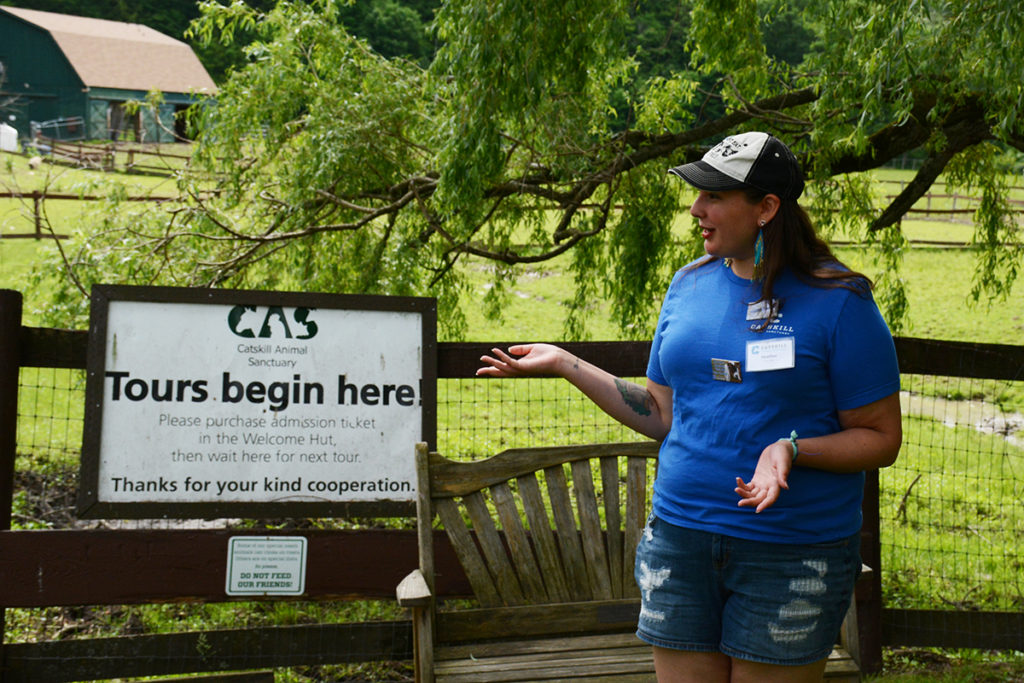
“So if you’re unfamiliar with what veganism means, it’s simply a way of living one’s life with respect for all animals,” says Heather Stadler, tour guide at Catskill Animal Sanctuary. Photo by Christine Oser.
When I arrived at the Catskill Animal Sanctuary on Sunday morning, eight golden-haired sheep grazed the grassy area alongside the parking lot. One of the sheep, more tan than gold, walked alongside us during the beginning of the tour. I would come to know him as Stewie. Unafraid to show affection, Stewie pressed up against the legs of another visitor, signaling his interest in her continued petting. “The sheep came from a pretty nasty rescue in Westport, Massachusetts,” Stadler says. Before arriving here, the sheep and many other animals at the location lived in filthy, waste- and disease-riddled environments. “So, of course as you can imagine, if you had been forced to live in conditions like that, when they first came here they were very untrusting, scared, and sad.”
But Heather says the sheep, especially Stewie, overcame their timidness. Many of them feel comfortable walking right up to strangers. But not all the animals share Stewie’s enthusiasm for humans. As the tour progressed, Heather walked us up to an L-shaped enclosure where several horse halters hung. Tucked away in the small green run-in shed, only taking up a fraction of the space given to them, stood two horses, Ashley and Pliers. The mother-son duo came to the sanctuary after being rescued from owners who couldn’t afford their care. Ashley, an Appaloosa horse, struggles with the disease uveitis, which makes the sun’s rays very harmful to her eyes. Eventually Ashley went blind, and the family who owned her lacked the financial reserves to take care of her.
“We sent a trailer over, and we brought them here instead,” says Heather. “When they first arrived, Pliers was incredibly aggressive. He was very, very overprotective of his mother. He had kind of become her eyes.” Since arriving, Pliers and Ashley have gotten used to their new home. When Ashley wanders out too far, she’ll whinny for Pliers and navigate her way back to their small barn.
“There is no difference there between a cat or a man. The idea of difference is a human conception for man’s own advantage.”
Although Pliers and Ashley were lucky enough to stay together as mother and son, many animals at the sanctuary are separated from their parents. We walked around to the other end of the property, where Heather pointed out a cow at the far end of the field. Weighing 3,000 pounds, the brown- and white-spotted animal Heather described as a “teddy bear” was named Tucker. Heather looked at us and asked, “Does anyone know why Tucker isn’t with his mom?”
She then told us the story of a cow whose children were stripped away from her. After giving birth to twins, the mother hid one of her calves in the wooded area near her farm — realizing that losing one child was better than losing two. She would escape each day to the woods to feed her calf, but that meant going back to the farm with empty udders. The farmers got suspicious and followed the cow out to the woods, where they found the baby calf and sold it for its leather.
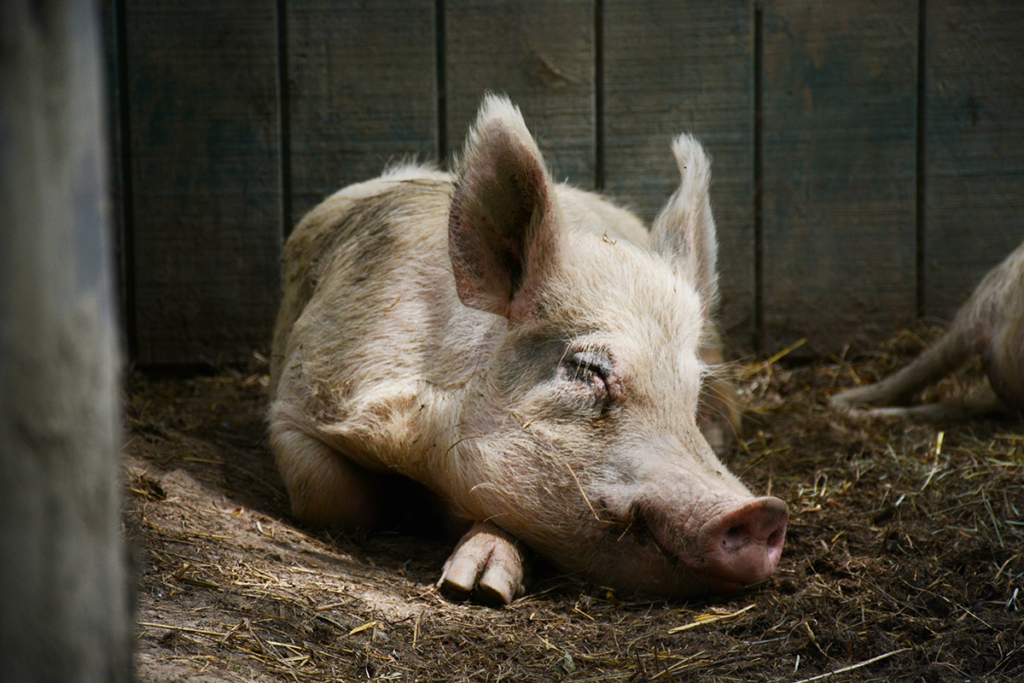
“Pigs are just like dogs except they’re about 10 times smarter,” Stadler says. Photo by Christine Oser.

“When we take in a being here who’s broken physically and often psychologically, we say to him or her with everything that we have, ‘You’re safe, you’re loved, and your life matters,’” says Stadler. Photo by Christine Oser.
This isn’t Tucker’s story. But, it easily could have been. He was stripped from his mother and sent to a petting zoo planning to sell him at auction. Instead, he was saved by two zoo visitors and brought to the sanctuary. Tucker’s story is the exception—in agriculture, and in America. Mothers being stripped from their children is a common story in our country’s history — from slavery to current immigration narratives. As Heather told the story of the mother cow, I began to remember the narratives of the African diaspora. I thought of Harriet Jacobs from Incidents in the Life of A Slave Girl and Solomon Northup from 12 Years a Slave. These stories demonstrated to me the definition of tragedy. As I stood with my arms draped over Tucker’s fence, I thought about how tragedy takes many forms, in America and in the agricultural industry, especially as it relates to the destruction of families. These connections wandered through my mind as I walked back to my car.
I pulled away from the parking lot and drove back up the winding road. I decided to stop at the top of the hill for a photo. I peered through the trees, overlooking those same pastoral fields I’d seen when I drove in that first day. There at the top of the hill I saw the tour guides, Tucker, and the acreage we walked. As the sun began to set over the property, I put down the camera and looked out over the hill. I decided to sit and watch, following Tucker as he ate and ambled, the evening sun casting him in a warm glow.
Banner photo by Christine Oser.



